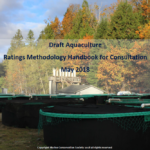GAA Responds to MCS Draft Ratings System
The Global Aquaculture Alliance (GAA) is pleased to contribute to the public consultation on the Marine Conservation Society (MCS) Draft Aquaculture Ratings Methodology Handbook.
 According to the United Kingdom-based conservation organization, the handbook provides in-depth discussion of how MCS assesses the environmental performance of various aquaculture production methods. It is aimed at MCS assessors and staff, consultants, seafood businesses and other professionals requiring a thorough understanding of the MCS farmed seafood ratings methodology.
According to the United Kingdom-based conservation organization, the handbook provides in-depth discussion of how MCS assesses the environmental performance of various aquaculture production methods. It is aimed at MCS assessors and staff, consultants, seafood businesses and other professionals requiring a thorough understanding of the MCS farmed seafood ratings methodology.
GAA, through its Best Aquaculture Practices (BAP) third-party certification program, administers a farm-level inspection and certification program for responsible aquaculture and it shares many objectives with MCS. Farm certification provides assurance with a high degree of granularity, while ranking systems like MCS attempt to condense broad impact assessments into summary scores for specific species produced in specific regions or countries. Importantly, BAP also has a comprehensive approach that covers hatcheries, feed mills and processing plants to account for impacts all along the supply chain.
GAA appreciates the logic and systematics of the MCS ranking system and is pleased to note that the scoring system takes account of both positives and negatives in reaching a composite score. However, overall the system is still inadvertently biased against aquaculture, particularly in comparison to alternative food production systems. As such it has the potential to direct consumers away from seafood consumption to the detriment of their health.
For example, the criterion 2E (Source of Juveniles) is inadequately weighted to reflect the importance of using hatchery-reared stocks. Fish farming has demonstrated its ability to increase global supplies of seafood (while output from wild fisheries has stagnated) and it has been able to grow precisely because it uses hatchery-reared stocks. Captive breeding and domestication are fundamental features of successful food production systems, and they reveal how the world has managed to move away from reliance on hunting and gathering. In the MCS scoring system, use of hatcheries, and/or closed breeding cycles, deserves a big positive score (+5) to reflect this. If the MCS is to do justice to its Responsible Seafood mission, it should champion responsible aquaculture as well as incentivize continual improvement. Certifications, such as BAP and the Aquaculture Stewardship Council (ASC), insist on hatchery juveniles for fish and shrimp farms and can be used to inform judgements on criterion 2E.
The MCS system references farm certifications but some, notably BAP four star, extend beyond farms to include hatcheries, feed mills and processors. All these stages in the production chain have potential impacts that need to be managed. Although the MCS criteria are restricted to an environmental and animal welfare focus, consumers are also concerned about the welfare of the workers that produce their food. Thus certification programs that also address and verify social and community impacts in a comprehensive way, e.g. BAP and Fair Trade, should result in higher MCS seafood rankings.



